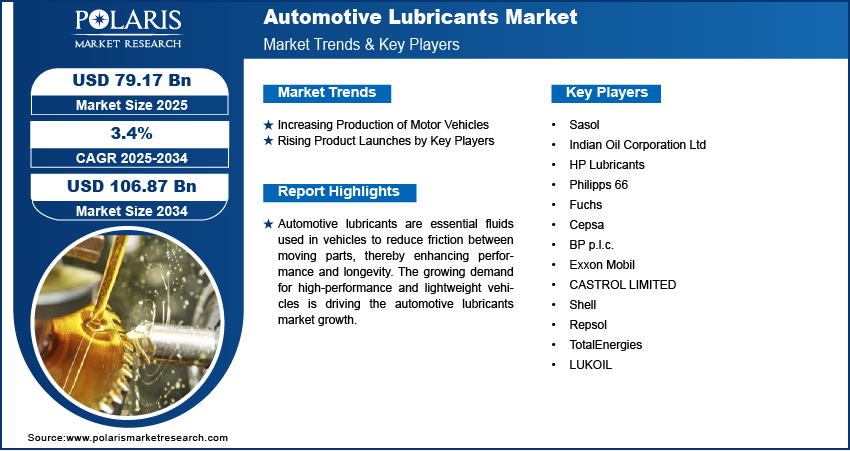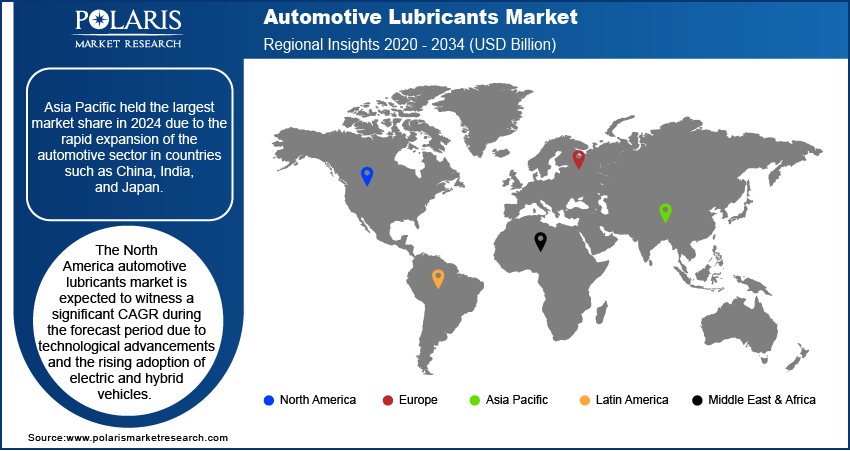
Automotive Lubricants Market Share, Size, Trends, Industry Analysis Report,
By Product (Engine Oil, Brake Fluids, Gear Oil, Coolants, Transmission and Hydraulic Fluids); By Vehicle Type; By Oil Type; By Region; Segment Forecast, 2024 - 2032
- Published Date:Jan-2024
- Pages: 113
- Format: PDF
- Report ID: PM1119
- Base Year: 2023
- Historical Data: 2019-2022
Report Outlook
The global Automotive Lubricants Market is projected to witness robust growth. It was valued at USD 72.34 billion in 2023 and is projected to grow to USD 98.59 Billion By 2032, exhibiting a CAGR of 3.60% over the forecast period, 2024 – 2032
Automotive lubricants reduce friction in contact areas, such as the vehicle and a road, which protects automotive components and enhances the performance of a vehicle. The capability to move particles, shift forces, and heat up or cool down surfaces are all other conceivable uses. It is formulated using a variety of additives and base oils sourced from different categories based on their intended applications.

To Understand More About this Research: Request a Free Sample Report
The essential applications of automotive lubricants contain engine, gear, and hydraulic oils. The expanding utilization of high-performance lubricants is anticipated to drive market growth. The significant surge in both automotive sales and infrastructure development in emerging nations has led to a substantial increase in the demand for these lubricants and coolants. Additional factors propelling the lubricant and coolant industry include a growing need for both light passenger and heavy-duty vehicles, escalating conventional fuel costs, and a rise in the average lifespan of vehicles.
The surging focus on fuel efficiency and emissions control requirements by governments worldwide is a key driver of the automotive lubricants market's revenue growth. Automotive lubricants play an essential role in reducing pollutants, enhancing fuel economy, and reducing engine friction. Accordingly, lubricant manufacturers are classifying the development of innovative lubricants that comply with the latest environmental regulations, assisting automakers in meeting their fuel efficiency targets.
The COVID-19 pandemic has significantly impacted the automotive lubricants market, causing both short-term disruptions and long-term shifts in the industry. The initial phase of the pandemic witnessed a sharp decline in automotive manufacturing and transportation activities, which led to reduced demand for lubricants. Lockdowns, supply chain disruptions, and economic anticipations resulted in decreased vehicle production and lower vehicle usage, affecting the need for lubricants across the automotive sector.
Moreover, the pandemic has accelerated trends towards electric vehicles (EVs). As automotive manufacturers increasingly focus on sustainable and environmentally friendly technologies, the composition and specifications of lubricants are evolving to meet the unique requirements of these new propulsion systems. This shift is anticipated to have an enduring impact on the type and volume of lubricants demanded by the automotive industry.
As economies slowly reopened, the automotive lubricants market witnessed a sluggish recovery, driven by the resumption of manufacturing and increased mobility. However, the recovery has been uneven across regions, with some areas experiencing a rapid rebound than others. The shift towards remote work and changes in consumer behavior, including a preference for private transportation over public transit, have also influenced the demand for lubricants in specific segments of the automotive market.

For Specific Research Requirements: Request for Customized Report
The surge in automotive manufacturing, accompanied by a transition from heavy to lightweight vehicles, stands as a key factor. A 10% decrease in an automobile's weight leads to fuel savings ranging from 5% to 7%. Additionally, the diminished weight plays a crucial role in managing CO2 emissions throughout the vehicle's life cycle, contributing to enhanced overall performance in terms of acceleration and handling.
Industry Dynamics
Growth Drivers
- Increasing adoption of high-performance automotive lubricants drives the growth of the market
The market growth of automotive lubricants is primarily driven by the rising adoption of high-performance automotive lubricants. The automotive sector has experienced a significant transformation, witnessing a surge in the need for high-performance automotive lubricants. This heightened demand is attributed to their capacity to boost performance, decrease emissions, and prolong the lifespan of equipment. These cutting-edge lubricants, distinguished by their exceptional thermal stability, resistance to oxidation and rust, and effective wear protection, are gaining popularity among both automotive manufacturers and vehicle owners. The increasing preference for high-performance automotive lubricants is propelling the market forward by optimizing performance and constraining maintenance expenses.
The evolving automotive technology landscape, including the widespread adoption of electric vehicles and hybrid systems, presents new opportunities for lubricant manufacturers. These emerging technologies frequently require specialized lubricants to meet the exceptional demands of electric and advanced transmission systems. The ongoing focus on sustainability and environmental consciousness has also prompted the industry to innovate eco-friendly lubricants, aligning with global efforts to reduce the environmental impact of automotive functions. Growing engine complexity and the desire for extended maintenance intervals drive demand for high-performance automotive lubricants, prompting manufacturers to invest in research for formulations that provide prolonged durability and protection.
Report Segmentation
The market is primarily segmented based on product, vehicle type, oil type, and region.
|
By Product |
By Vehicle Type |
By Oil Type |
By Region |
|
|
|
|
To Understand the Scope of this Report: Speak to Analyst
By Product Analysis
- The engine oil segment held the largest revenue share in 2022
In 2022, the engine oil segment held the largest revenue share. Engine oils are highly used for the lubrication of inner combustion engines in automobiles. These high-performance lubricants are available in diverse categories, including part synthetic, fully synthetic, and mineral oils. Engine oils display a broad range of outstanding characteristics such as heat resistance, heat resistance strength, and high viscosity. Thus, all of these are bolstering the growth of engine oils.
On the other hand, the brake fluid segment is expected to witness substantial growth. Brake fluids serve as hydraulic fluids commonly utilized in the hydraulic braking and clutch systems of vehicles. Their primary role is to create a non-compressible medium, allowing the pressure applied by the driver's foot on the brake pedal to transmit effectively and engage the friction material against the discs.
By Vehicle Type Analysis
- The heavy commercial segment accounted for the highest market share
The heavy commercial segment accounted for the highest market share. The transportation of goods over long distances using heavy commercial vehicles requires the utilization of lubricants that offer exceptional performance, durability, and fuel efficiency. The increasing demand for reliable and efficient transportation, the surge in the adoption of electric and hybrid vehicles, and the rising need for heavy commercial vehicles are all contributing factors driving the increased demand for automotive lubricants in this segment.
On the other hand, light commercial vehicles are anticipated to experience significant growth. Light commercial vehicles serve diverse purposes, such as delivery services, public transportation, and transporting goods. These vehicles demand specialized lubricants to ensure superior performance, extended lifespan, and improved fuel efficiency. The growing demand for light commercial vehicles, fueled by the expanding e-commerce sector, the necessity for efficient last-mile delivery services, and the increasing popularity of electric vehicles, is propelling the need for advanced automotive lubricants in this market.

Regional Insights
- Asia Pacific dominated the largest market share
Asia Pacific dominated the largest market contributor in the automotive lubricants market. The substantial expansion in this sector can be ascribed to the progressing commercial automotive lubricants market in India, Japan, and China. As per OICA data, India experienced a notable 24% growth in vehicle production, totaling 5,456,857 units, which included commercial vehicles, three-wheelers, passenger vehicles, and two-wheelers. Moreover, Japan's automotive sector ranked as the third largest globally, encompasses 78 factories across 22 prefectures. Collectively, these factors are fueling the growth of the product market in the region.
Europe is accounted for the fastest growth in the automotive lubricants market. According to the European Commission, the automotive sector employs around 2.6 million individuals in the existing car manufacturing workforce, comprising roughly 8.5% of overall manufacturing employment within the European Union. Additionally, the Society of Motor Manufacturing and Traders (SMMT) predicts that the United Kingdom is anticipated to manufacture approximately 775,014 cars and 101,600 commercial vehicles.

Key Market Players & Competitive Insights
The market is characterized by intense competition, with established players relying on advanced technology, high-quality products, and a strong brand image to drive revenue growth. These companies employ various strategies such as research and development, mergers and acquisitions, and technological innovations to expand their product portfolios and maintain a competitive edge in the market.
Some of the major players operating in the global market include:
- Amsoil (Wisconsin)
- Arabol Lubricants
- Bel-Ray Company LLC.
- Bharat Petroleum
- Emulsichem Lubricants Pvt. Ltd.
- Eni S.P.A.
- Exxon Mobil Corporation
- Indian Oil Corporation
- Liqui Moly
- Lubrizol
- Morris Lubricants
- Peak Lubricants Pty Ltd
- Penrite Oil
- Phillips 66 Lubricants
- Rock Valley Oil and Chemical Co.
- Total Oil
- Ultrachem Inc
- Valvoline
Recent Developments
- In October 2022, TotalEnergies has partnered with MG Motor to develop a new range of lubricants in Chile. Anticipated to be branded as MG Oil, this pioneering automotive oil is meticulously tailored for MG Motor vehicles. The production of this innovative product is set to take place exclusively in Chile, a strategic move that is poised to enhance TotalEnergies' footprint in the region.
- In July 2022, Shell USA, Inc. and Shell Midstream Partners, L.P. have officially merged. Under this agreement, Shell USA will take ownership of all common units that represent limited partner interests in SHLX, amounting to an estimated total value of around USD 1.96 billion. The anticipated completion date for this transaction is the fourth quarter of 2022.
- In July 2021, Valvoline introduced All-Terrain, a new engine lubricant designed specifically for robust diesel engines utilized in demanding off-highway conditions, including construction, mining, and agriculture.
Automotive Lubricants Market Report Scope
|
Report Attributes |
Details |
|
Market size value in 2024 |
USD 74.41 billion |
|
Revenue forecast in 2032 |
USD 98.59 billion |
|
CAGR |
3.60% from 2024 – 2032 |
|
Base year |
2023 |
|
Historical data |
2019 – 2022 |
|
Forecast period |
2024 – 2032 |
|
Quantitative units |
Revenue in USD billion and CAGR from 2024 to 2032 |
|
Segments Covered |
By Product, By Vehicle Type, By Oil-Type, By Region |
|
Regional scope |
North America, Europe, Asia Pacific, Latin America; Middle East & Africa |
|
Customization |
Report customization as per your requirements with respect to countries, region and segmentation. |
Custom Market Research Services
Seeking a more personalized report that meets your specific business needs? At Polaris Market Research, we’ll customize the research report for you. Our custom research will comprehensively cover business data and information you need to make strategic decisions and stay ahead of the curve.
FAQ's
The global automotive lubricant market size is expected to reach USD 98.59 billion by 2032
Key players in the market are Amsoil (Wisconsin), Arabol Lubricants, Bel-Ray Company LLC., Bharat Petroleum, Emulsichem Lubricants Pvt. Ltd
Asia Pacific contribute notably towards the global automotive lubricants market
The global automotive lubricants market is expected to grow at a CAGR of 3.5% during the forecast period.
The automotive lubricants market report covering key segments are product, vehicle type, oil type, and region.
